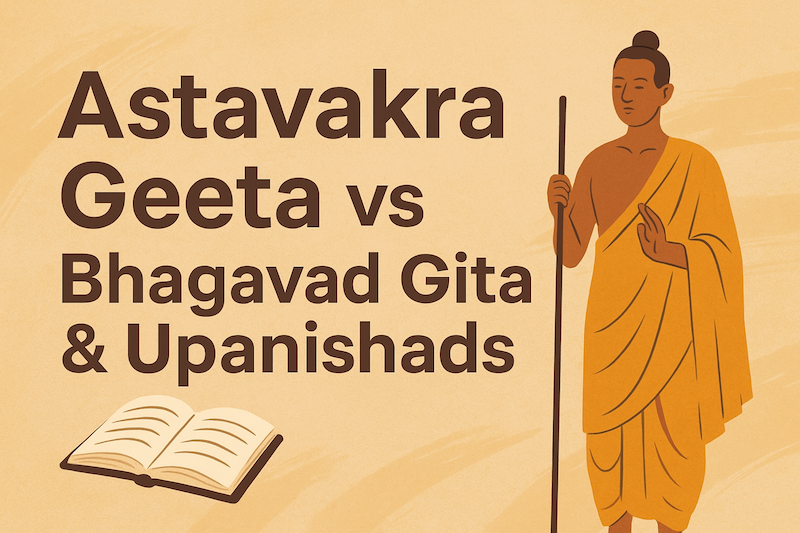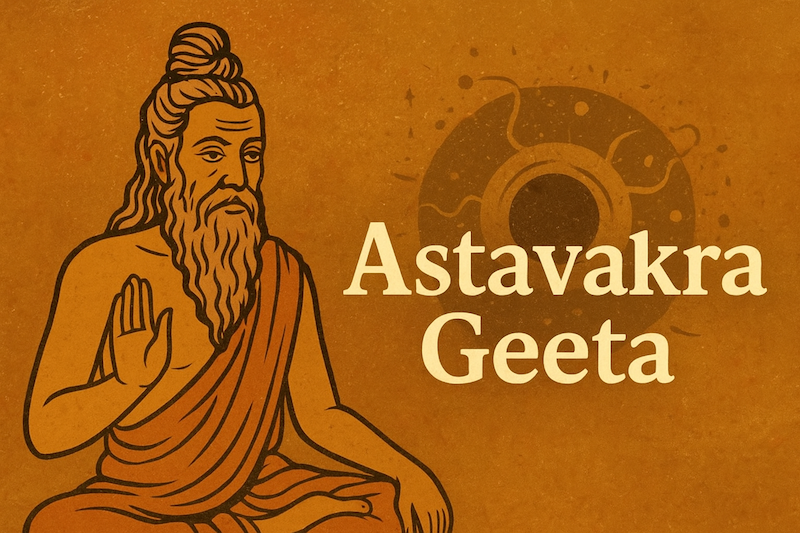The spiritual heritage of India is filled with profound texts—the Upanishads, the Bhagavad Gita, and the Astavakra Geeta stand as shining beacons. Each explores the nature of reality, the Self, and the path to liberation. Yet, the Astavakra Geeta stands out for its radical simplicity and directness. Let’s look at how it compares with these other classics.
The Upanishads: Seeds of Non-Duality
The Upanishads are some of the oldest spiritual scriptures, laying the foundation for Vedantic philosophy. They explore questions like: What is the Self? What is ultimate reality? What is the meaning of life?
Key features:
- Poetic, symbolic, and layered in meaning.
- Teachings are scattered across many texts.
- Encourage inquiry, meditation, and guidance from a guru.
The Upanishads are like a vast ocean of wisdom, offering multiple paths to realization.
The Bhagavad Gita: The Path of Action and Devotion
The Bhagavad Gita, spoken by Krishna to Arjuna on the battlefield of Kurukshetra, is one of the most widely read scriptures in the world.
Key features:
- Balances philosophy with practical duty.
- Teaches different yogas: Karma Yoga (action), Bhakti Yoga (devotion), and Jnana Yoga (knowledge).
- Encourages fulfilling one’s responsibilities with detachment.
The Gita blends spirituality with daily living, showing how to be both active in the world and rooted in truth.
The Astavakra Geeta: Radical Directness
Now enters the Astavakra Geeta—different from both the Upanishads and the Gita.
Key features:
- A single, continuous dialogue between Sage Astavakra and King Janaka.
- No rituals, duties, or practices—only pure wisdom.
- Declares that liberation is instant: “You are already free.”
- Strips away all complexities and points directly to awareness.
Where the Bhagavad Gita offers a path, the Astavakra Geeta reveals the destination itself. Where the Upanishads invite inquiry, Astavakra commands realization here and now.
Why Is Astavakra Geeta Unique?
- No Middle Path: While the Gita balances worldly duties with spiritual growth, the Astavakra Geeta boldly ignores duties, diving straight into Self-realization.
- Clarity Without Symbolism: Unlike the Upanishads, it avoids metaphors and speaks directly.
- Instant Freedom: It does not promise liberation after lifetimes of practice, but insists you are already free—if you stop identifying with the unreal.
Modern Relevance
In today’s fast-paced world, many seekers resonate with the Astavakra Geeta because it eliminates complexity. There’s no waiting, no conditions, no obligations—just a reminder of who you already are.
However, the Gita and Upanishads also remain deeply relevant for those who prefer a step-by-step journey. Together, these texts show the richness of India’s spiritual heritage.
Final Thoughts
The Astavakra Geeta, Bhagavad Gita, and Upanishads each shine in their own way. If the Upanishads are the roots, and the Bhagavad Gita is the guiding path, the Astavakra Geeta is the final declaration of truth.
In our next post, we’ll dive into the story of King Janaka, who became a living example of enlightenment while still ruling his kingdom.

